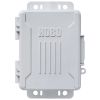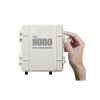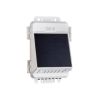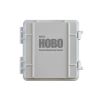Onset Temperature Smart Sensor
The Onset Temperature Smart Sensor provides < ± 0.2° C total accuracy (< ±0.36° F) and resolution of < ± 0.03° C (< ±0.054° F) over the range of 0° to 50° C (32° to 122° F).
Features
- Measurement range of -40° to 100°C (-40° to 212°F)
- Stainless steel sensor tip
- Sensor and cable rated for immersion in water or soil up to 50°C for up to 1 year
- Expedited repair and warranty service
- Lifetime technical support
- More
Overview
The Onet 12-bit Temperature Smart Sensor provides < ± 0.2° C total accuracy (< ±0.36° F) and resolution of < ± 0.03° C (< ±0.054° F) over the range of 0° to 50° C (32° to 122° F). The full measurement range is -40° to 100° C (-40° to 212° F). A selectable measurement-averaging feature further improves accuracy. Available in cable lengths of 2m, 6m and 17m.
|
Measurement Range |
-40° to 100°C (-40° to 212°F) – sensor tip |
| Accuracy | < ±0.2°C from 0° to 50°C (< ±0.36°F from 32° to 122°F)* |
| Resolution | <0.03°C from 0° to 50°C (<0.054°F from 32° to 122°F) |
| Drift | <0.1°C (0.18°F) per year** |
| Response Time (to 90% of change) | <2 minutes typical in 2 m/sec (4.5 mph) moving air flow <1 minute typical in stirred water bath |
| Environmental Operating Ranges | Smart sensor adapter: -40° to 75°C (-40°F to 167°F); weatherproof, IP67 Stainless-steel sensor tip and cable jacket: Waterproof over the range of -40° to 50°C (-40°F to 122°F) for 1 year; operation up to 100°C (212°F) in air |
| Housings | Stainless steel waterproof sensor tip; weatherproof polyamide housing for smart sensor adapter |
| Dimensions | Temperature probe: 5.0 x 26 mm (0.2 x 1.0 inches) |
| Weight | 2 meter: 0.09 g (3.3 oz) 6 meter: 0.14 g (5.2 oz) 17 meter: 0.30 g (11.2 oz) |
| Bits per Sample | 12 |
| Number of Data Channels*** | 1 |
| Measurement Averaging Option | Yes |
| Cable Lengths Available | 2 m (6.6 ft) S-TMB-M002 6 m (19.7 ft) S-TMB-M006 17 m (55.8 ft) S-TMB-M017 |
| Length of Smart Sensor Network Cable | 0.5 m (1.6 ft) for all models |
*Radiation Shield strongly recommended for use in sunlight (listed in Accessories tab)
**The drift specification of <0.1°C (0.18°F) per year may be exceeded when using the probe continuously in water >50°C (122°F).
***A single HOBO station can accommodate 15 data channels and up to 100 m (328 ft) of smart sensor cable (the digital communications portion of the sensor cables).
In The News
Sargassum Surge: How Seaweed is Transforming our Oceans and Coastal Ecosystems
Until recently, Sargassum –a free-floating seaweed–was distributed throughout the Sargasso Sea , the north Caribbean Sea, and the Gulf of Mexico. But in the space of a decade, this seaweed has, as one scientist remarks , “Gone from a nonfactor to the source of a terrible crisis.” Driven by climate change, anomalous North Atlantic Oscillation in 2009-2010 and a glut of anthropogenic pollutants, sargassum has proliferated. Seasonally recurrent mats as deep as 7m now bloom in the “Great Atlantic Sargassum Belt” (GASB), which covers areas of the Atlantic from West Africa to the Caribbean Sea and Gulf of Mexico. Every year, millions of tons wash up along the shores of more than 30 countries . Dr.
Read MoreGreat Lakes Research Center: Designing Targeted Monitoring Solutions
According to the National Oceanic and Atmospheric Administration ( NOAA ), the Great Lakes have more miles of coastline than the contiguous Atlantic and Pacific coasts combined and contain 20 percent of the world's freshwater, making it a critical region to protect and conserve. Continuous monitoring and data-informed resource management are key components of managing waters in the region. Hayden Henderson, a research engineer with the Great Lakes Research Center (GLRC), designs and deploys monitoring platforms throughout the Great Lakes. With a background in environmental engineering, Henderson enjoyed the challenge of creating systems and making them work to obtain difficult, remote measurements.
Read MoreMonitoring Meadowbrook Creek: Real-Time Data Collection in an Urban Creek
Meadowbrook Creek in Syracuse, New York, has been monitored by Syracuse University (SU) faculty and students for over a decade. Originally established by Dr. Laura Lautz in 2012, the early years of the program focused on collecting grab water samples for laboratory analysis and evaluating the impact of urban land use, human activities, and natural processes on water resources. Tao Wen , an Assistant Professor in SU’s Department of Earth and Environmental Sciences, took over the program in 2020 and upgraded the existing systems to include 4G modems that allowed for real-time data viewing. [caption id="attachment_39339" align="alignnone" width="940"] An overview of the Fellows Ave monitoring station along Meadowbrook Creek.
Read More



















